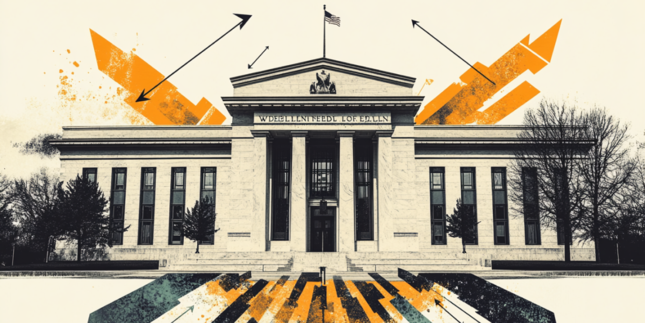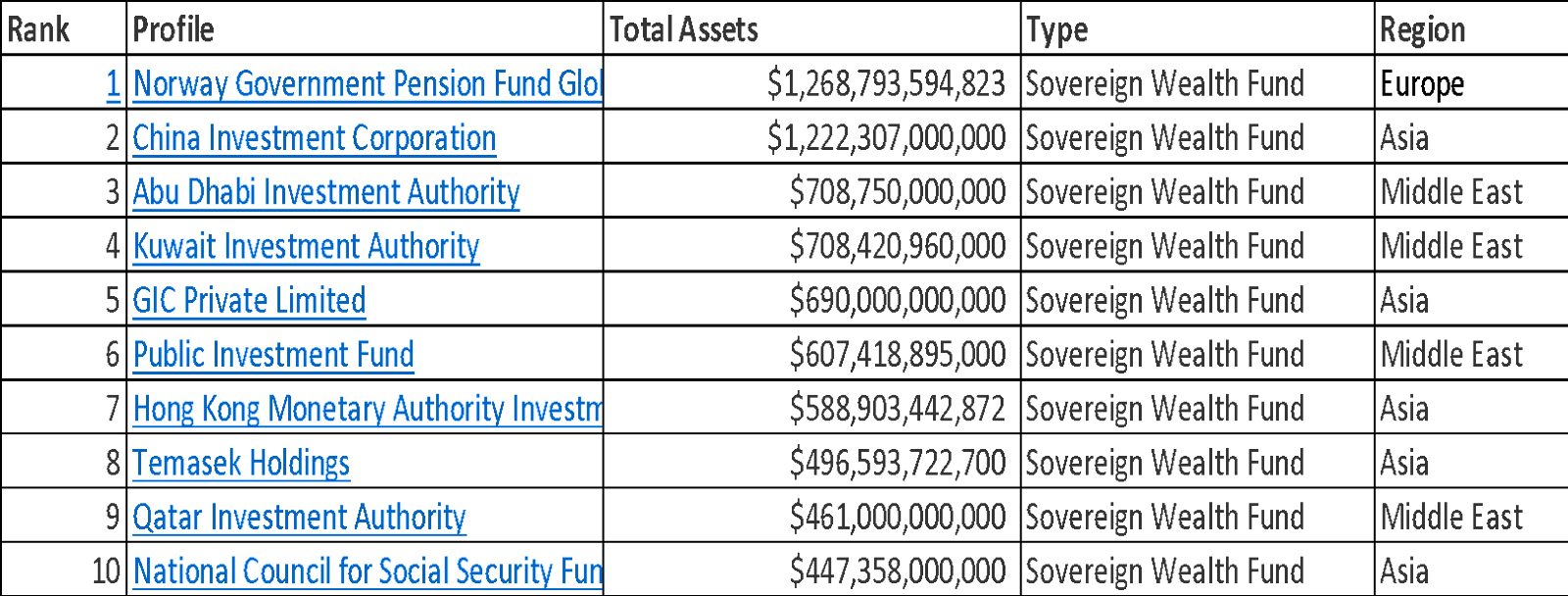Sovereign Wealth Funds (SWF) have become diversified investment vehicles that invest across equity and fixed income products, but also are active players in private equity and in early-stage tech companies. As we look at the global landscape for SWFs, it is not surprising that of the largest 10 SWF, with a combined $7.6 trillion in assets, 70 percent of these are from oil and gas producers.
What are sovereign wealth funds?
A sovereign wealth fund is a state-owned investment fund investing money generated by the government, often derived from a country's surplus reserves and natural resource industries. SWFs aim to build wealth for a country's economy and its citizens.
Popular sources of SWF are surplus from state-owned oil and gas, and trade surpluses. SWF are used to preserve capital and generate financial returns that can be used to increase prosperity of a country and its citizens. Oil and gas producers are known for using their SWF to diversify their investments away from energy and to boost the country's competitiveness. This is a well-known strategy in the Gulf Cooperation Council (GCC). Wealthy nations traditionally use sovereign wealth funds to invest surplus billions overseas to prevent inflation at home, diversify income streams and accumulate savings. Norway and Chile are two good examples using their SWFs to save oil and copper revenues respectively in the form of sovereign wealth funds. These actions have prevented these two resource rich countries from experiencing Dutch Disease, also known as the ‘resource curse’ which could have led to high inflation at home and affected competitiveness across other less strategic sectors.
The Gulf Cooperation Council SWF are different
While Kuwait’s sovereign wealth fund was the first global SWF to be established in 1953, most GCC SWF were created following the oil and gas booms of the 70s, and they very much followed the Norway traditional model of structure and investment strategy. They are all controlled by the ruling families, such as with Saudi Crown Prince Mohammed bin Salman (MBS) as Chairman of the Public Investment Fund (PIF) and Emirati President Sheikh Khalifa bin Zayed Al Nahyan as Chairman of the Abu Dhabi Investment Authority (ADIA). In so doing, these monarchies can maintain close control over how the countries’ resource wealth is spent and align that spending with their political, public, and personal objectives.
Most SWFs in the GCC are commodity-based funds, though a small proportion represent non-commodity funds equivalent to 7% of total fund assets. Overall, the Gulf “Magnificent Seven” SWF have combined assets of $3,2 trillion amounting to approximately 40% of SWFs global assets. These seven SWF are the Abu Dhabi Investment Authority ($829 billion), the Kuwait Investment Authority ($769 billion), the Saudi Public Investment Fund ($620 billion), the Qatar Investment Authority ($445 billion), the Investment Corporation of Dubai ($300 billion), Abu Dhabi's Mubadala ($284 billion) and Abu Dhabi ADQ ($108 billion). The state-owned investment funds invest in equity, bonds, realestate, startup, and any other asset class that can lead to frothy returns.
The GCC particularly, Qatar, Saudi and Abu-Dhabi, have used sovereign vehicles to promote their political agenda, and have become prominent investors in tourism, arts, cities development (at home), football, golf, and formula one. Saudi Arabia, Qatar and UAE have been promoting local real estate and property investment funding the infrastructure needed for new cities, as well as housing complexes, and ports, hoping to attract cosmopolitan foreign residents and businesses. Generally speaking, GCC SWF invests in iconic projects such as in the 500-billion-dollar NEOM city (in Saudi Arabia), which require massive financing resources, and which aims to promote the national brand projecting international prestige.
Other caliber of sovereign wealth fund
Smaller and less financially endowed countries, ranging from Morocco, Mauritius, and Panama, have also developed their own strategic investment fund. While these are smaller in size, ranging from $500 million to $1,5 billion, they all aim to get on the global map, and become more trustworthy as they seek to invest their revenue streams more responsibly. These types of funds tend to be common in countries which are over-dependent on one type of revenue source, Mauritius relying on tourism, and Panama, relying on its canal operations and refueling capabilities.
What to expect going forward?
As climate regulation, sustainability investment and ESG pressure accelerates, oil gas and minerals dependent countries will take more risk and diversify aggressively their investments and shift away from oil and gas. This is why Saudi Arabia and Abu Dhabi are becoming the biggest supporters of Blue Hydrogen (derived from fossil fuels) which creates the infrastructure to make Green Hydrogen cost competitive. GCC countries through their SWFs are becoming the biggest investors and promoters at home of sustainable futuristic cities. In other words, by 2050, GCC countries could be the leading renewable energy producing countries in the world, owners of “zero emission cities” of the world, and pioneers of clean tech and sustainable farming. Time to buckle up!
All information posted is for educational and information use only, and it should never replace professional advice. Should you decide to act upon any information in this article, you do so at your own risk.
Recommended Content
Editors’ Picks

Gold gives away some gains, slips back to $2,980
Gold retraced from its earlier all-time highs above the key $3,000 mark on Friday, finding a footing around $2,980 per troy ounce. Profit-taking, rising US yields, and a shift to a risk-on environment seem to be putting the brakes on further gains for the metal.

EUR/USD remains firm and near the 1.0900 barrier
EUR/USD is finding its footing and trading comfortably in positive territory as the week wraps up, shaking off two consecutive daily pullbacks and setting its sights back on the pivotal 1.0900 mark—and beyond.

GBP/USD remains depressed, treads water in the low-1.2900s
GBP/USD is holding steady in consolidation territory after Friday’s opening bell on Wall Street, hovering in the low-1.2900 range. This resilience comes despite disappointing UK data and persistent selling pressure on the USD.

Crypto Today: BNB, OKB, BGB tokens rally as BTC, Shiba Inu and Chainlink lead market rebound
Cryptocurrencies sector rose by 0.13% in early European trading on Friday, adding $352 million in aggregate valuation. With BNB, OKB and BGB attracting demand amid intense market volatility, the exchange-based native tokens sector added $1.9 billion.

Week ahead – Central banks in focus amid trade war turmoil
Fed decides on policy amid recession fears. Yen traders lock gaze on BoJ for hike signals. SNB seen cutting interest rates by another 25bps. BoE to stand pat after February’s dovish cut.

The Best brokers to trade EUR/USD
SPONSORED Discover the top brokers for trading EUR/USD in 2025. Our list features brokers with competitive spreads, fast execution, and powerful platforms. Whether you're a beginner or an expert, find the right partner to navigate the dynamic Forex market.
